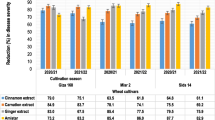Abstract
Mycoparasitic isolates colonizing Puccinia graminis.f.sp. tritici of wheat under field conditions was isolated and purified. Morphological studies established the identity of the isolates as Acremonium sclerotigenum (Moreau & R. Moreau ex Valenta) W. Gams. In screening for the in vitro mycoparasitic activity, by blending the conidial suspension of the mycoparasitic isolate, SHZA1, with the uredospores of the respective rust pathogens, a significant reduction in germination of uredospores and germ tube elongation of cereal rust pathogens viz., stem rust (Puccinia graminis.f.sp. tritici), leaf rust (Puccinia triticina) of wheat, stem rust (P. graminis f.sp. avenae), and crown rust (P. coronata f.sp. avenae) of oats were observed. The culture filtrate of the mycoparasite also inhibited the uredospore germination of the rust fungi and was more effective than the spore suspension. Under glasshouse conditions, spraying of the culture filtrate of SHZA1 suppressed the development of uredosori of rusts. Given potential mycoparasitism, the identity of the isolate was validated by sequencing the ITS region of rDNA.





Similar content being viewed by others
References
Choi GJ, Kim JC, Jang KS, Cho KY, Kim HT (2008) Mycoparasitism of Acremonium strictum BCP on Botrytis cinerea, the gray mold pathogen. J Microbiol Biotechnol 18(1):167–170
Demirci E, Dane E, Eken C (2011) In vitro antagonistic activity of fungi isolated from sclerotia on potato tubers against Rhizoctonia solani. Turk J Biol 35:457–462. https://doi.org/10.3906/biy-1004-98
Domsch KH, Gams W, Anderson TH (2007) Compendium of soil fungi. IHW-Verlag and Verlagsbuchhandlung, Germany, p 627
Ghule SB, Sawant IS, Sawant SD, Sujoy Saha, Devarumath RM (2019) Isolation and identification of three new mycoparasites of Erysiphe necator for biological control of grapevine powdery mildew. Australas Plant Pathol 48:351–367. https://doi.org/10.1007/s13313-019-00636-0
Leinhos GME, Buchenauer H (1992) Hyperparasitism of selected fungi on rust fungi of cereal. J Plant Dis Prot 99(5):482–498
Liu Yuelian L Qingfang (2013) Inhibitory effects of Acremonium sp. on Fusarium wilt in bananas. Afr J Agric Res 8(48):6241–6249. https://doi.org/10.5897/AJAR2013
Lo Piccolo S, Alfonzo A, Giambra S, Conigliaro G, Lopez-Llorca LV, Burruano S (2015) Identification of Acremonium isolates from grapevines and evaluation of their antagonism towards Plasmopara viticola. Ann Microbiol 65:2393–2403
Malathrakis NE (1985) The fungus Acremonium alternatum Line: Fr., a hyperparasite of the cucurbits powdery mildew pathogen Sphaerotheca fuliginea. J Plant Dis Prot 92(5):509–515
Minas K, McEwan NR, Newbold CJ, Scott KP (2011) Optimization of a high-throughput CTAB-based protocol for the extraction of qPCR-grade DNA from rumen fluid, plant and bacterial pure cultures. FEMS Microbiol Lett 325(2):162–169. https://doi.org/10.1111/j.1574-6968.2011.02424.x
Priyamvada, Saharan MS, Ratan T (2011) Durable resistance in wheat. Int J Genet Mol Biology 3(8):108–114
Rivera VV, Freeman TA, Gudmestad NC (2007) Mycoparasitism of Helminthosporium solani by Acremonium strictum. Phytopathology 9:1331–1337
Roopali S, Kabdwal BC, Kumar J (2019) Success Stories of Biological Control. Biocontrol lab, Department of Plant Pathology College of Agricultrue, GBPUA&T, Pantnagar. Availablevia. https://www.gbpuat.ac.in/success_story/14.11.2019 Success_Story.pdf
Sanjay A, Shivaji W, Manish M, Pabel M (2021) Rust of Wheat. In: Technical Booklet No.02 (2020-21), Directorate of Plant Protection, Quarantine & Storage. Available via.https://ppqs.gov.in/sites/default/files/wheat_rust-english.pdf
Sathiyabama B (2018) Protection of groundnut plants from rust disease by application of glucan isolated from a biocontrol agent Acremonium obclavatum. Int J Biol Macromol 116:316–319
White TJ, Bruns T, Lee S, Taylor J (1990) Amplification and direct sequencing of fungal ribosomal RNA genes for phylogenetics. In: InnisMA,Gelfand DH, Sninsky JJ, White TJ (eds) PCR protocols: a guide to methods and applications. Academic Press, Inc, New York, p 315
Author information
Authors and Affiliations
Corresponding author
Additional information
Publisher’s Note
Springer Nature remains neutral with regard to jurisdictional claims in published maps and institutional affiliations.
Rights and permissions
Springer Nature or its licensor (e.g. a society or other partner) holds exclusive rights to this article under a publishing agreement with the author(s) or other rightsholder(s); author self-archiving of the accepted manuscript version of this article is solely governed by the terms of such publishing agreement and applicable law.
About this article
Cite this article
Chandrasekaran, U.M., Perumal, N., Balakrishnan, A. et al. Biocontrol potential of Acremonium sclerotigenum (Moreau & R. Moreau ex Valenta) W. Gams against wheat and oat rust fungi (Puccinia species). Indian Phytopathology (2024). https://doi.org/10.1007/s42360-024-00752-y
Received:
Revised:
Accepted:
Published:
DOI: https://doi.org/10.1007/s42360-024-00752-y




